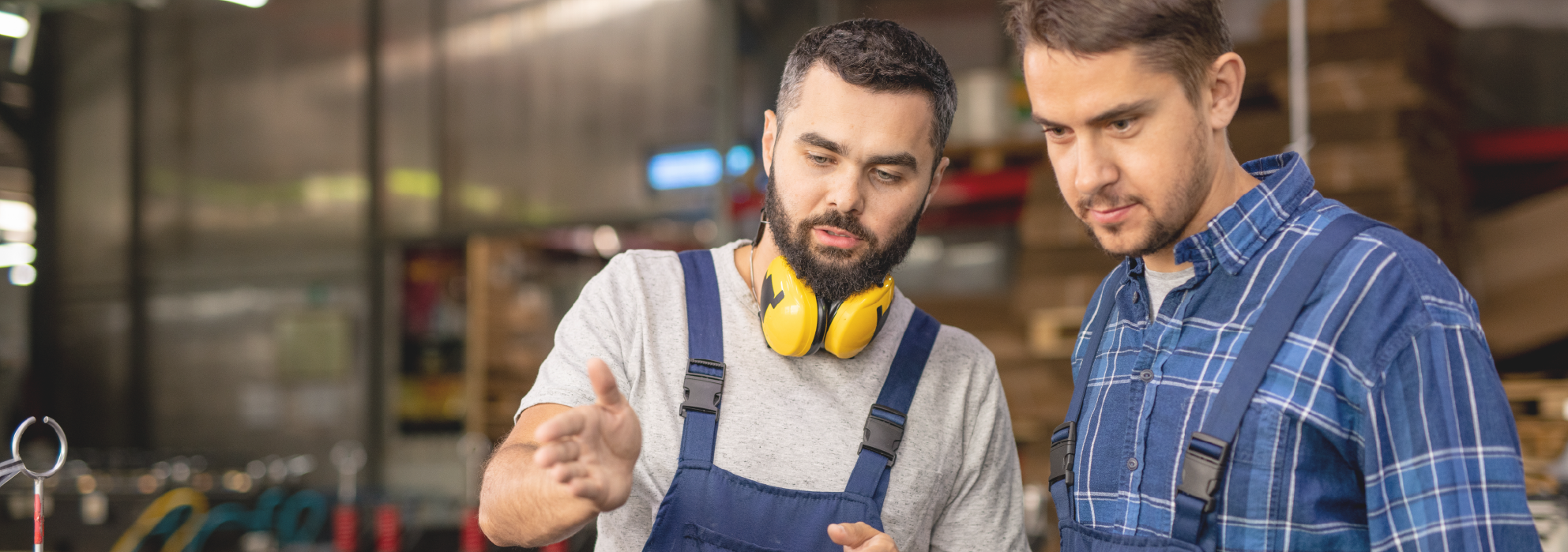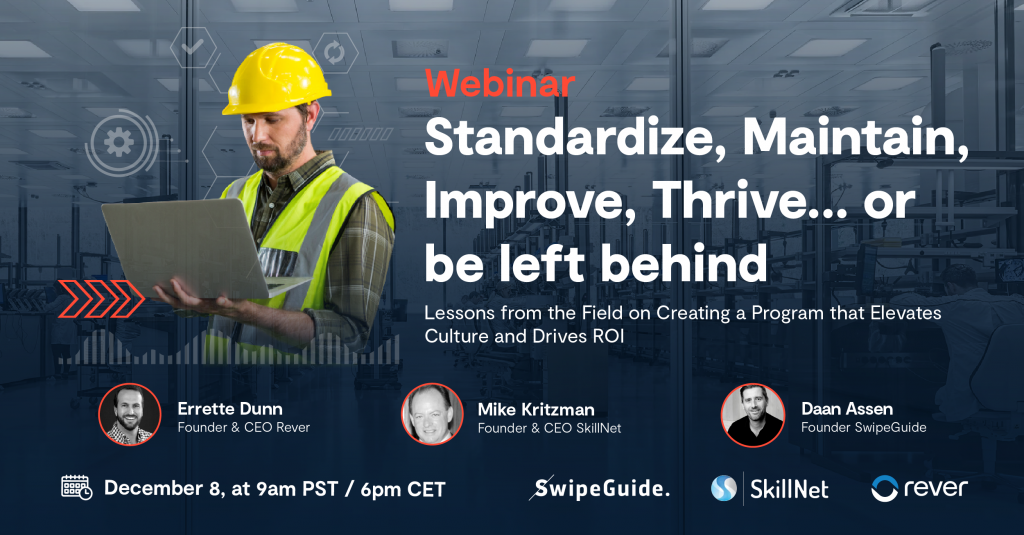Series (3/6): Driving Continuous Improvement
6 minutes, 21 seconds read

Learn more about, and connect with, our presenters on LinkedIn:
Errette Dunn, Founder & CEO Rever (learn more about Rever)
Daan Assen, C0-founder SwipeGuide (learn more about SwipeGuide)
Mike Kritzman, Founder & CEO SkillNet (learn more about SkillNet)
Host: Ralf VonSosen, Chief Solution Office, Rever
In this segment, we examine how to build a continuous improvement program that engages the frontline and transforms company culture.
Watch here! See the live discussion.
Ralf VonSosen:
Let’s talk a little bit more about driving a successful continuous improvement program. Errette, I know this is a big part of your core about what you grew up with in Toyota. Maybe you talk a little bit about how you are seeing, and how your customers have specific programs that are being successful.
Errette Dunn:
First, I like to define, or broaden, the definition of continuous improvement because in most people’s minds, continuous improvement is just a campaign of collecting people’s ideas and suggestions. While everybody agrees, that is a good thing to do, unfortunately it’s never an urgent thing for most companies. Companies see that flavor of continuous improvement as a nice to have. Whenever all my other problems and issues and fires in the factory are solved then I’ll do continuous improvement. No. In my definition, continuous improvement touches any sort of problem solving, troubleshooting, and fixing issues in your factory. That is the culture of continuous resolution, continuous improvement of your operations, continuous troubleshooting. So continuous improvement is not only about doing a once a year campaign or Kaizen workshops where you incentivize people to participate in a given scope of issues and reward them.
Those campaigns and workshops are a good thing, and they have their place in transforming a culture, but ultimately you have to set up the mechanisms so that people are continuously examining the standard so they can identify whenever there’s a gap versus the standard. Identifying issues, identifying problems, and knowing what to do to solve them. That is continuous improvement: when that happens continuously, not just at events or campaigns, not just once a year when you’re giving people rewards. So the main recommendation is to set up this continuous improvement, continuous troubleshooting, and continuous problem solving program for your company. It is an absolute necessity to make sure that everybody is enabled to be a true problem solver in your organization, not just the experts and not just the green belts and black belts.Every single person has the basics of solving problems. One way to do that is to connect them with each other and give them access to knowledge, access to previous experiences, access to previous problems so that they don’t have to reinvent the wheel every single time. This way they can collaborate across departments, even across factories. The technology is a great enabler and catalyst for a continuous improvement culture.
Ralf VonSosen:
Having this resource center of learning alongside the standards that we were just talking about. Mike, what have you seen in terms of making sure that people that have the right knowledge or as qualified when setting a new standard.
Mike Kritzman:
When a process changes, how do you make sure that everybody knows that? A new robot has a software update, there’s a new machine. These things require an update in terms of the capabilities of the workforce, to be able to get the job done with this new approach and to make sure that they can quickly learn it. It’s important to have a dashboard that shows what individuals are capable of doing. It’s knowing what to do and then making sure people are doing it. These need to go hand in hand. This also touches on the importance of cross training.
Ralf VonSosen:
Daan I’m really curious to what the conversation is like when you’re implementing SwipeGuide and they are digitizing their processes and standards. How do they make sure that if the standard changes, it changes appropriately?
Daan Assen:
It’s important to at least have the feedback loop. So when you talk about standard work, people follow it, and you capture the feedback from the process and try to incorporate it again in the standards that makes it a dynamic standard. And that’s what we see in the companies that are successful connecting standard work and continuous improvement. One of the very important things is that it is also the culture. People feel empowered, when they contribute ideas. Are they feeling heard in that sense?If not, this program will never fly. The cultural and change management aspect is important to really give the people on the frontline the feeling that if they identify things that can be improved, that they have the opportunity to incorporate it into their daily work. Having an empowerment culture is critical to a successful program.
Ralf VonSosen:
That actually leads well into the topic of collaboration and how that’s changed. Errette, you were talking about somebody observing something that’s out of standard, or sub-optimal. How do they find a way to address it and turn that learning into new standards?
Errette Dunn:
I want to emphasize again on the word collaboration. If you look at the Latin root of collaboration as working together with somebody. But, very often in manufacturing environments, supply chain environments, and any other work environments there are these walls where work gets defined in one place and gets thrown over the wall to the other side, and then they figure out how to do it. This is especially true in industrial settings where we design a product, it gets thrown over to industrial engineering. They design how it’s going to be built, and then it gets thrown into the factory. Now you build it and run your factory. The frontline operator has now been thrown some standards, and is now supposed to execute it.
Actually the collaboration between frontline workers, frontline supervisors, industrial engineers, maintenance, quality, even engineering and design, should be to work together on improving those standards. And actually one of the best ways to collaborate is on finding root causes of problems. Especially chronic problems, things that repeat and over and over. So that’s one good opportunity because it’s not just about getting along together better. It’s about putting the tools in place and the communication systems in place to work together on solving issues at the root and getting the knowledge from the frontline to the office with the engineers. Technology is an enabler for eliminating friction and enabling that sort of collaboration.
Mike Kritzman:
These silos are everywhere and tech helps create tunnels.
Read more from this wonderful discussion:
- Adjusting Operations to the Ongoing Pandemic (1 of 6)
- Power of Standardization and Standard Work (2 of 6)
- Driving Continuous Improvement (3 of 6)
- Building and Managing Skills (4 of 6)
- Leveraging the Power of Technology (5 of 6)
- Advice for 2022 – It’s about your people (6 of 6)
OR, watch the Video Recordings (each is 5-10min in length):
- Adjusting Operations to the Ongoing Pandemic (1 of 6)
- Power of Standardization and Standard Work (2 of 6)
- Driving Continuous Improvement (3 of 6)
- Building and Managing Skills (4 of 6)
- Leveraging the Power of Technology (5 of 6)
- Advice for 2022 – It’s about your people (6 of 6)
Like this content? Sign up for our Newsletter
[hubspot type=form portal=561211 id=fda6d445-739e-4072-8dae-68b94971a266]THE FRONTLINE DOJO
More Articles
How to develop the next billion Knowledge Workers
3 minutes, 51 seconds read
Digital transformation in manufacturing is not what you think it is
10 minutes, 36 seconds read
The human side of change management: lessons learned from Toyota, Airbus, and Silicon Valley
1 minute, 28 seconds read
The true meaning of Genchi Genbutsu
3 minutes, 5 seconds read
